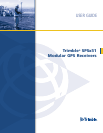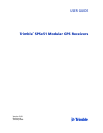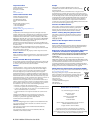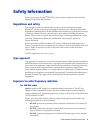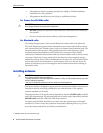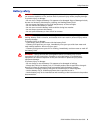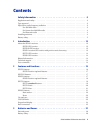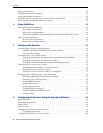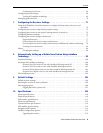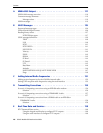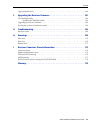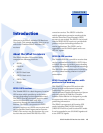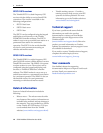SPSx51 Modular GPS Receivers User Guide 3
Safety Information
Before you use your Trimble
®
SPS GPS receiver, make sure that you have read and
understood all safety requirements.
Regulations and safety
The receivers contain an internal radio-modem and can send signals through
Bluetooth
®
wireless technology or through an external data communications radio.
Regulations regarding the use of the 450 MHz radio-modems vary greatly from country
to country. In some countries, the unit can be used without obtaining an end-user
license. Other countries require end-user licensing. For licensing information, consult
your local Trimble dealer. Bluetooth and 900 MHz radio-modems operate in
license-free bands.
Before operating an SPSx51 Modular GPS receiver, determine if authorization or a
license to operate the unit is required in your country. It is the responsibility of the end
user to obtain an operator’s permit or license for the receiver for the location or
country of use.
For FCC regulations, see Notices, page 2.
Type approval
Type approval, or acceptance, covers technical parameters of the equipment related to
emissions that can cause interference. Type approval is granted to the manufacturer of
the transmission equipment, independent from the operation or licensing of the units.
Some countries have unique technical requirements for operation in particular
radio-modem frequency bands. To comply with those requirements, Trimble may have
modified your equipment to be granted Type approval. Unauthorized modification of
the units voids the Type approval, the warranty, and the operational license of the
equipment.
Exposure to radio frequency radiation
For 450 MHz radio
Safety. Exposure to RF energy is an important safety consideration. The FCC has
adopted a safety standard for human exposure to radio frequency electromagnetic
energy emitted by FCC regulated equipment as a result of its actions in General Docket
79-144 on March 13, 1986.
Proper use of this radio modem results in exposure below government limits. The
following precautions are recommended:
• DO NOT operate the transmitter when someone is within 20 cm (7.8 inches) of
the antenna.
• DO NOT operate the transmitter unless all RF connectors are secure and any
open connectors are properly terminated.
• DO NOT operate the equipment near electrical blasting caps or in an explosive
atmosphere.



